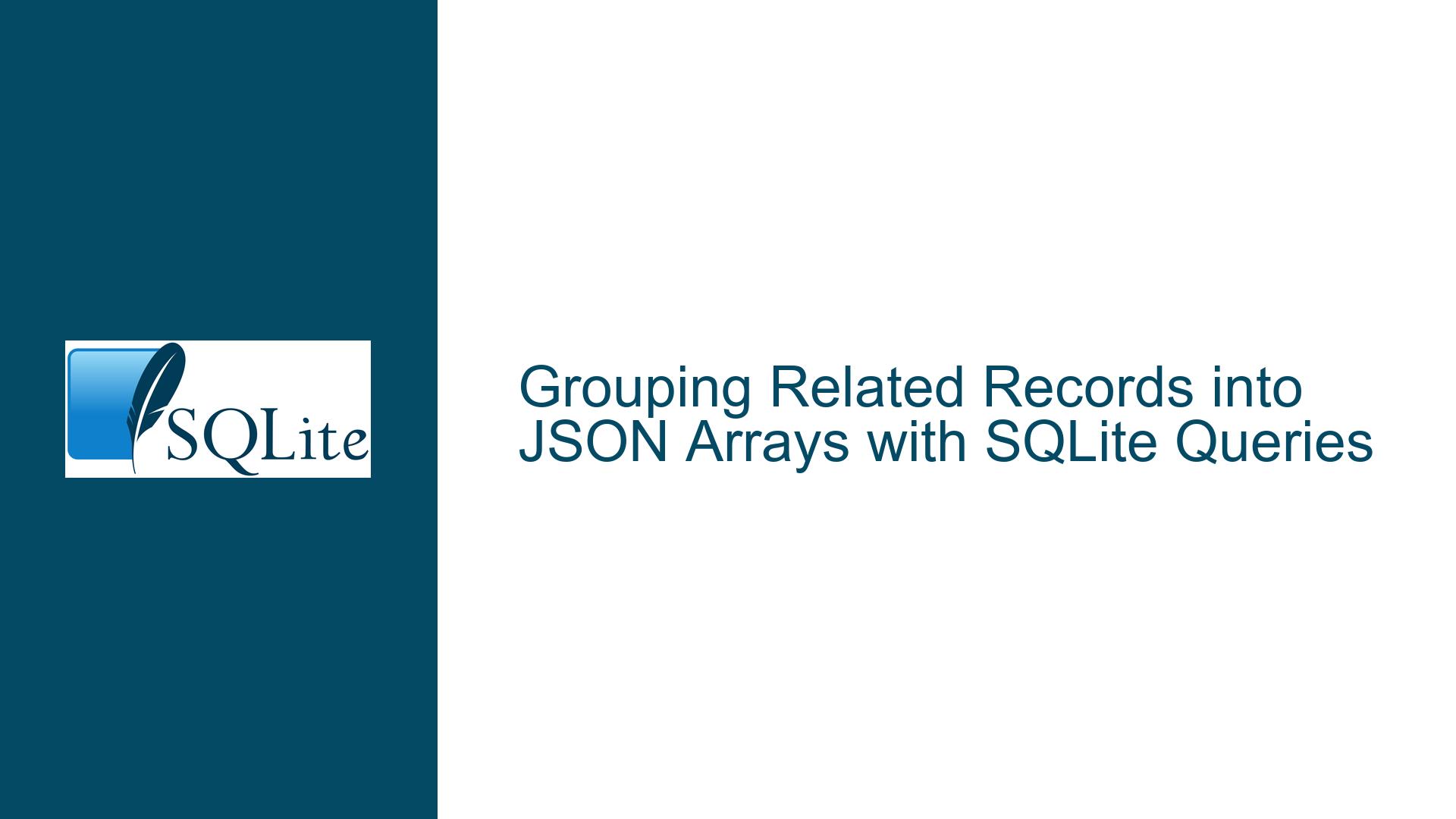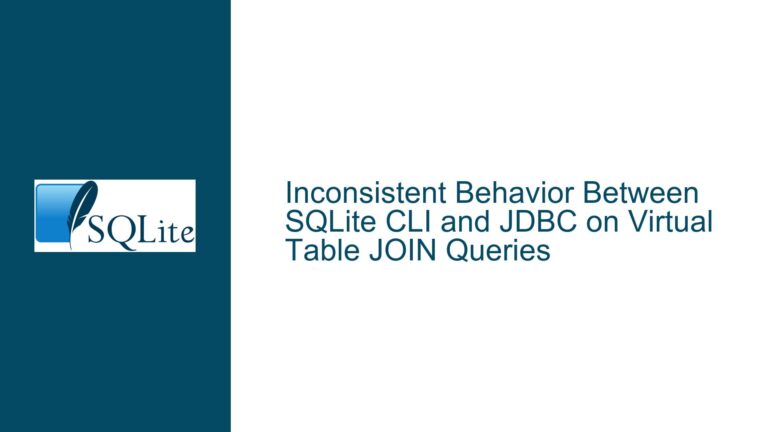Grouping Related Records into JSON Arrays with SQLite Queries
Understanding the Core Challenge of Aggregating Child Records in JSON Output
The central challenge in this scenario revolves around efficiently transforming a one-to-many relational database structure into nested JSON arrays while maintaining performance with large datasets. The database contains three tables with the following relationships:
- Table
a: Parent table containing titles (1:many relationship withb) - Table
b: Child table containing URLs (many:1 relationship witha, 1:many relationship withc) - Table
c: Grandchild table containing geospatial coordinates (many:1 relationship witha)
The desired output requires:
- One JSON object per
brecord - Each object containing an array of all related
crecords - Preservation of individual
c_idvalues within location arrays - Efficient handling of 800K+ records in
aand million+ records inc
Critical Analysis of Query Structure and Performance Limitations
Fundamental Data Modeling Constraints
The primary obstacle stems from SQLite’s JSON capabilities operating at the row level rather than set level. When combining relational data with JSON aggregation, developers face three key challenges:
Nested Aggregation Limitations:
- SQLite’s
json_group_array()operates within a single grouping level - Multiple levels of aggregation require nested subqueries
- Typical JOIN operations create Cartesian products that break aggregation
- SQLite’s
Indexing Requirements:
- Without proper indexes on
a_idcolumns, subqueries become full table scans - The current table structure lacks composite indexes for join optimization
- Without proper indexes on
Pagination Complexity:
- Traditional
LIMIT/OFFSETbecomes impractical with large datasets - Offset-based pagination requires scanning all previous rows
- Key-based pagination requires understanding of data distribution
- Traditional
Common Pitfalls in Initial Approaches
The original attempts demonstrate several conceptual misunderstandings:
Incorrect Grouping Level:
- Grouping by
c.idcreates unnecessary fragmentation - Proper grouping should occur at the
b.idlevel
- Grouping by
JSON Function Misapplication:
- Direct use of aggregated strings without
json()conversion - Improper nesting of JSON objects within arrays
- Direct use of aggregated strings without
Suboptimal Join Strategies:
- Cartesian product creation through multiple JOINs
- Lack of correlation between main query and subqueries
Comprehensive Solution Strategy for Efficient JSON Aggregation
Step 1: Optimized Query Structure with Correlated Subqueries
Base Query Template:
WITH paginated_b AS (
SELECT
b.id AS b_id,
b.url,
a.id AS a_id,
a.a_title
FROM b
JOIN a ON b.a_id = a.id
ORDER BY b.id
LIMIT 30
)
SELECT json_group_array(
json_object(
'b_id', pb.b_id,
'url', pb.url,
'a_id', pb.a_id,
'a_title', pb.a_title,
'loc', (
SELECT json_group_array(
json_object(
'c_id', c.id,
'lat', c.lat,
'lon', c.lon
)
)
FROM c
WHERE c.a_id = pb.a_id
)
)
)
FROM paginated_b pb;
Key Optimization Features:
- CTE for Pagination: Isolates the base
brecords first - Correlated Subquery: Fetches locations per
a_idwithout JOIN explosion - Direct JSON Construction: Builds nested structures in single pass
Step 2: Index Optimization Strategy
Essential Indexes:
CREATE INDEX idx_b_a_id ON b(a_id);
CREATE INDEX idx_c_a_id ON c(a_id);
CREATE INDEX idx_b_pagination ON b(id, a_id);
Index Rationale:
idx_b_a_id: Enables fast lookups when joiningbtoaidx_c_a_id: Optimizes location subqueries bya_ididx_b_pagination: Supports both ordering and filtering in pagination
Step 3: Advanced Pagination Implementation
Offset-Free Pagination Technique:
WITH paginated_b AS (
SELECT
b.id AS b_id,
b.url,
a.id AS a_id,
a.a_title
FROM b
JOIN a ON b.a_id = a.id
WHERE b.id > ? -- Last seen b_id from previous page
ORDER BY b.id
LIMIT 30
)
-- Rest of query remains identical
Performance Benefits:
- Eliminates
OFFSETscanning penalty - Uses seek method with indexed
b.idcomparisons - Consistent performance regardless of page depth
Step 4: Handling Sparse Locations
Modified Location Subquery:
SELECT COALESCE(
json_group_array(
json_object(
'c_id', c.id,
'lat', c.lat,
'lon', c.lon
)
),
json_array() -- Handle cases with zero locations
)
FROM c
WHERE c.a_id = pb.a_id
Key Features:
COALESCEensures valid JSON arrays even with missing locations- Maintains consistent output structure across all records
- Prevents NULL values from breaking JSON structure
Step 5: Query Plan Analysis and Tuning
Execution Plan Examination:
EXPLAIN QUERY PLAN
WITH paginated_b AS (...)
SELECT ...;
Expected Optimal Plan:
SCAN TABLE b USING INDEX idx_b_paginationSEARCH TABLE a USING INTEGER PRIMARY KEY (rowid=?)SEARCH TABLE c USING INDEX idx_c_a_id (a_id=?)
Tuning Considerations:
- Ensure all subqueries show
USING INDEX - Watch for
TEMPORARY B-TREEin EXPLAIN OUTPUT (indicates missed indexes) - Consider increasing cache size for large working sets:
PRAGMA cache_size = -10000;
Step 6: Memory Management for Large Results
Configuration Tweaks:
PRAGMA mmap_size = 1073741824; -- 1GB memory mapping
PRAGMA temp_store = MEMORY; -- Keep temp structures in RAM
PRAGMA journal_mode = OFF; -- For read-only queries
Application-Level Streaming:
- Process JSON results in chunks using Python’s
ijsonor similar - Avoid loading entire JSON array into memory
- Use generator patterns for response serialization
Step 7: Alternative Materialized View Approach
For read-heavy workloads with infrequent data changes:
Materialized View Creation:
CREATE TABLE b_loc_cache (
b_id INTEGER PRIMARY KEY,
url TEXT,
a_id INTEGER,
a_title TEXT,
loc_json TEXT
);
CREATE INDEX idx_b_loc_a ON b_loc_cache(a_id);
Refresh Strategy:
- Use triggers on underlying tables
- Periodic rebuilds during maintenance windows
- Query becomes simple
SELECT loc_json FROM b_loc_cache
Step 8: Benchmarking and Validation
Performance Test Methodology:
- Warm cache with
PRAGMA schema.wal_checkpoint(TRUNCATE); - Time first-run vs cached execution
- Monitor memory usage with
sqlite3_status() - Verify JSON output validity using
json_valid()
Expected Metrics:
- Sub-100ms response for 30-record pages with proper indexes
- Linear scalability up to 1M records
- Memory usage under 50MB for typical configurations
Step 9: Client-Side Processing Tradeoffs
When SQL-side JSON becomes prohibitive:
Alternative Approach:
SELECT
b.id AS b_id,
b.url,
a.id AS a_id,
a.a_title,
c.id AS c_id,
c.lat,
c.lon
FROM b
JOIN a ON b.a_id = a.id
LEFT JOIN c ON c.a_id = a.id
WHERE b.id > ?
ORDER BY b.id
LIMIT 30;
Client-Side Processing:
- Group records by
b_idin application code - Build JSON structure programmatically
- Benefits from simpler SQL but increases network payload
Step 10: Concurrency Considerations
Isolation Levels:
- Use
BEGIN IMMEDIATEfor write operations READ UNCOMMITTEDacceptable for bulk reads- Enable WAL mode for concurrent access:
PRAGMA journal_mode=WAL;
Connection Pooling:
- Reuse prepared statements
- Set appropriate busy timeouts
- Monitor for lock contention during heavy writes
Final Implementation Checklist
Index Verification:
- Confirm all
a_idcolumns are indexed - Validate composite index on
b(id, a_id)
- Confirm all
Query Validation:
- Test with empty
crecords - Verify pagination boundary conditions
- Check JSON output validity
- Test with empty
Performance Profiling:
- Run EXPLAIN QUERY PLAN
- Monitor memory usage during large exports
- Test with production-scale data samples
Application Integration:
- Implement error handling for JSON parsing
- Add timeout controls for long-running queries
- Consider connection pool sizing
This comprehensive approach addresses both the immediate JSON formatting requirements and the broader performance considerations inherent in large-scale SQLite deployments. The solution balances SQL capabilities with application-level optimizations, providing a robust foundation for high-performance JSON aggregation in resource-constrained environments.






